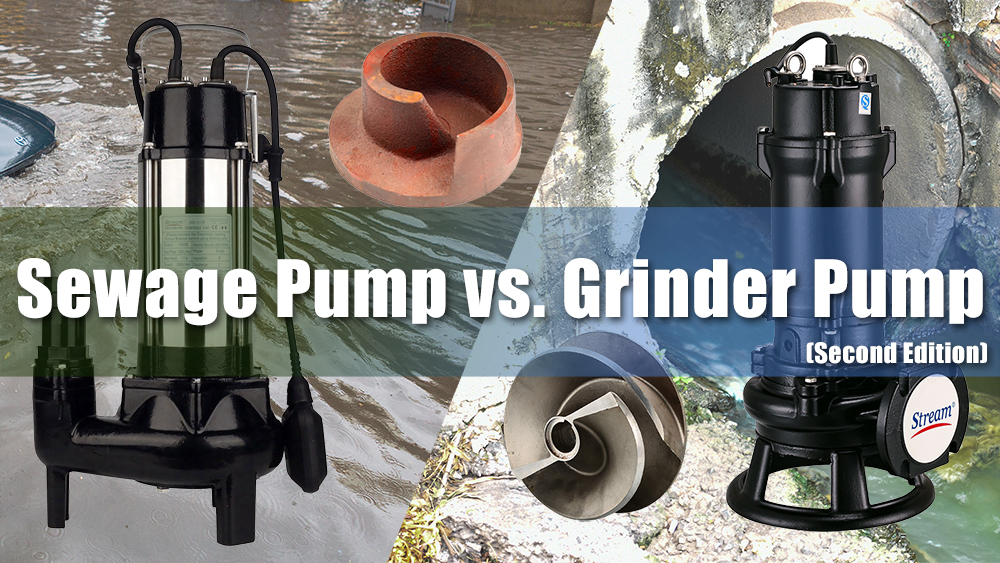+86 13816508465
Pump Introductions
Feb. 19, 2025

Similarities
1.Purpose: Both sewage and grinder pumps are designed to transport wastewater containing solids and other debris from one point to another, typically from a lower elevation to a higher one.
2.Operation: Both pumps use an electric motor to drive a rotating impeller that moves the fluid. They are commonly used in residential, commercial, and industrial settings to manage wastewater.
3.Materials: Both types of pumps are typically made of durable, corrosion-resistant materials like stainless steel or cast iron to withstand harsh conditions in wastewater handling.
Differences
1.Cutting Mechanism:
Sewage Pump: Generally designed to handle sewage with larger solids but does not have a cutting function. It is used for basic sewage and wastewater pumping applications where debris is not too large or tough.
Grinder Pump: Equipped with a grinder or cutter mechanism, this pump can break down solids into smaller pieces before they are pumped. It is ideal for handling tougher waste, such as items that might clog a sewage pump, like tree branches, rags, and heavy solids.
2.Flow Rate and Pressure:
Sewage Pump: Typically provides a higher flow rate at lower pressures, making it ideal for straightforward sewage applications.
Grinder Pump: Provides a lower flow rate but can handle higher pressures due to its grinding mechanism, which is necessary for processing more solid waste and transporting it over longer distances.
Advantages
Sewage Pump:
Cost-Effective: Sewage pumps are generally more affordable because they lack the additional grinder mechanism.
Simple Operation: Suitable for standard wastewater applications where the solids are relatively small and manageable.
Lower Maintenance: Since sewage pumps do not have complex cutting parts, they tend to require less maintenance.
Grinder Pump:
Versatile: Can handle a wider variety of wastewater, including solids that are difficult for regular sewage pumps to handle.
Longer Distance Capability: Capable of pumping wastewater over long distances or to higher elevations, thanks to the grinding function that reduces the size of solids, allowing for easier transport.
Prevents Clogging: The grinder mechanism ensures that solids are finely shredded, preventing blockages in pipes and sewer lines.
Disadvantages
Sewage Pump:
Limited Solid Handling: It may clog or become damaged when dealing with large debris or tough solids.
Less Suitable for Long-Distance Transport: Without a grinder, it’s less effective for pumping wastewater over long distances or through narrow pipes.
Grinder Pump:
Higher Cost: The additional grinding mechanism makes grinder pumps more expensive to purchase and maintain.
More Complex Maintenance: Grinder pumps have moving parts, such as blades, that require regular inspection and servicing to prevent wear and tear.
Energy Consumption: Grinder pumps generally consume more energy because of the extra work required to grind solids before pumping.
Best Applications for Each Pump
Sewage Pump:
Residential Use: Ideal for homes or buildings with basic wastewater disposal needs where the waste is primarily liquid with small solid content.
Simple Commercial Settings: Works well in applications like pumping wastewater from toilets or sinks, provided the solid content is not too large or hard.
Grinder Pump:
Municipal Wastewater Systems: Suitable for municipal and industrial applications where solid waste (such as rags, plastics, or food waste) is a concern, and clogging could cause serious issues.
Septic Systems: Ideal for pumping wastewater from homes with septic tanks, especially where solids need to be ground down before being sent through the system.
Long-Distance Transport: Grinder pumps are perfect for scenarios where wastewater needs to be moved over long distances or at high elevations, like from a basement to the main sewage line.
Choosing the Right Pump
When to Choose a Sewage Pump:
Use when the wastewater contains mostly liquid and small solids. Sewage pumps are best for simple applications that don’t involve large or tough debris.
Choose for cost-effectiveness and simpler maintenance when handling relatively cleaner wastewater.
When to Choose a Grinder Pump:
Opt for a grinder pump if your wastewater contains large solids or items that could cause clogging (e.g., rags, tree branches, or debris from industrial processes).
Choose if you need to pump wastewater over long distances, as the grinder pump’s higher pressure capabilities are necessary for this type of application.
Common Failures and Troubleshooting
Sewage Pump:
Clogs: Due to larger debris, sewage pumps may get clogged. Regular maintenance and avoiding pumping hard-to-handle materials can reduce this risk.
Motor Failure: Motor issues can arise from overheating or electrical problems. Ensure the pump is adequately sized for the job and monitor for signs of stress.
Grinder Pump:
Grinder Blade Wear: The grinding mechanism can wear down over time, especially if tough materials like metals or plastic are pumped. Regular inspections are needed to ensure blades are sharp and effective.
Blockages: While grinder pumps are designed to handle tough waste, they can still become blocked if the waste is improperly disposed of (e.g., non-biodegradable items). Always ensure only appropriate materials are pumped.
Address
No.17 XeDa Jimei Ind. Park, Xiqing Economic Development Area, Tianjin, China
Telephone
+86 13816508465
QUICK LINKS